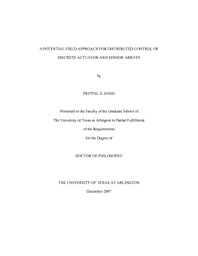
ATTENTION: The works hosted here are being migrated to a new repository that will consolidate resources, improve discoverability, and better show UTA's research impact on the global community. We will update authors as the migration progresses. Please see MavMatrix for more information.
Show simple item record
| dc.contributor.author | Dang, Pritpal S. | en_US |
| dc.date.accessioned | 2008-04-22T02:41:33Z | |
| dc.date.available | 2008-04-22T02:41:33Z | |
| dc.date.issued | 2008-04-22T02:41:33Z | |
| dc.date.submitted | December 2007 | en_US |
| dc.identifier.other | DISS-1946 | en_US |
| dc.identifier.uri | http://hdl.handle.net/10106/752 | |
| dc.description.abstract | This dissertation presents new methods of distributed sensing, classification and actuation using potential field and neural network approaches. Human look-a-like robot serves as an excellent tool to implement the strategies developed for sensing, classification and actuation. Achieving dexterity in human-machine interaction or human look-a-like robot helps in better understanding of dynamic and complex environment. This work deals with the issues related to gain autonomy and adaptability through distributed sensing, classification and actuation capabilities. The work presented here starts by mentioning novel strategies employed for morphing a flexible structure to achieve the desired expressions on the artificial skin and then moves on to classification of facial expressions for humanoid robot and the final part mentions about the strategies for sensing and localization of mobile platforms.
A complete humanoid robot is one which not only is able to classify expressions but also achieve the required expression by morphing the flexible surface (artificial skin). In this work, a control law is designed using a certain potential field for morphing flexible structures with and without model parameter uncertainties and it also presents a novel method called as Extended Orthogonal Least Square (EOLS) method to select the actuators that needs to controlled. The EOLS method achieves the desired shape of the flexible surface by optimally activating the microactuators embedded in the flexible surface.
This work also presents a novel and robust method to classify expressions using a two stage neural network. Expression classification plays a major role to increase human-machine interfacing. It also serves as a tool for humanoid robots to gain more realistic behavior. A new approach termed as semi-decoupled extended Kalman filter is proposed for 3D object pose estimation. This approach helps in gaining robust classification when a human face is under motion.
Distributed sensing has received considerable attention in the field of localization of mobile platforms. The mobile platforms could be aerial vehicles, humanoid robots or ground vehicles. This work presents a novel approach based on dynamics localization to estimate the relative and absolute position of the mobile platforms | en_US |
| dc.description.sponsorship | Lewis, Frank | en_US |
| dc.language.iso | EN | en_US |
| dc.publisher | Electrical Engineering | en_US |
| dc.title | A Potential Field Approach For Distributed Control Of Discrete Actuator And Sensor Arrays | en_US |
| dc.type | Ph.D. | en_US |
| dc.contributor.committeeChair | Lewis, Frank | en_US |
| dc.degree.department | Electrical Engineering | en_US |
| dc.degree.discipline | Electrical Engineering | en_US |
| dc.degree.grantor | University of Texas at Arlington | en_US |
| dc.degree.level | doctoral | en_US |
| dc.degree.name | Ph.D. | en_US |
| dc.identifier.externalLink | https://www.uta.edu/ra/real/editprofile.php?onlyview=1&pid=27 | |
| dc.identifier.externalLinkDescription | Link to Research Profiles | |
Files in this item
- Name:
- umi-uta-1946.pdf
- Size:
- 2.877Mb
- Format:
- PDF
This item appears in the following Collection(s)
Show simple item record


